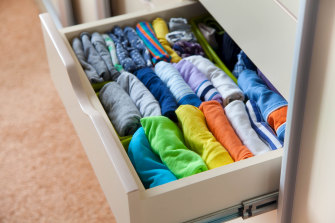Opinion
Jessica Irvine
Economics writer
I came to the startling realisation this week that I haven’t bought a single item of clothing in 2020.
The average Australian household spends $290 a year on clothes for its menfolk and $690 cladding its women.
If we want to talk about a gender finance gap, let’s start there, shall we?
That is not to say that some men are not incredibly partial to an overpriced suit, or that some women love a more minimalist wardrobe.
However, overall, women pay more to get dressed each morning.
But not me. At least, not any more.

Lovingly folded piles of neat clothing Marie Kondo-style will bring you more joy than negativity.Credit:
While conducting a comprehensive wardrobe cleanout, I realised that all of the items contained within were either purchased before 2020 or acquired free.
Friends, it was not always this way. Among my wardrobe evictees this week is a black coat from the former women’s fashion brand Willow that I’m pretty sure I paid about $600 for a decade ago.
It has been replaced by a black winter coat I joyfully seized from atop a pile of household items waiting for council collection in my suburb a few weeks ago. Ditto a pink and white striped T-shirt.
Two cardigans were acquired when I went to collect a free tent offered on Facebook Marketplace from an older couple offloading the possessions of their adult children.
I credit my new-found clothing frugality to my recently acquired super-sized mortgage, alongside the teachings of Japanese organising guru Marie Kondo, which I have followed since first reading her bestselling book The Life-Changing Magic of Tidying Up in about 2014.
Since then, I’ve “Kondo-ed” my possessions several times, embarking on periodic purges of clothing, books, household items and sentimental objects.
Stuff keeps creeping back in, of course. But overall, I’ve downsized dramatically.
In dire need of another organisational adrenaline rush while working from home, I impulsively spent a lunch break throwing the entire contents of my wardrobe onto my bed, where I proceeded to leave them for a couple of hours.
Just before bedtime, in dire need of a place to sleep, I began my sort and purge. In accordance with Kondo’s advice, I individually held each item and decided if it “sparked joy”.
As I did this, I happened to also be listening to a new podcast by economists Betsey Stevenson and Justin Wolfers called Think Like an Economist.
The two activities combined, it dawned on me why the Kondo regime has always held special appeal. I don’t know if she realises it, but Kondo herself is a closet economist.
The entire Kondo method is about making decisions about your possessions. Economists, too, love decisionmaking. Indeed, the entire point of economics is to help optimise allocation of scarce resources, such as time and money. Kondo’s method does just that.
First, her advice to keep only items which “spark joy” is essentially an encouragement to consider the costs versus benefits of owning each item. For instance, does the joy sparked by each item outweigh the distress you may experience at owning too many items?
Just like economists, Kondo also urges you to “think at the margin” – and I’ll explain what that means.
When you’re overhauling your wardrobe, you don’t sit down in advance and decide how many pairs of socks you should own. Should it be five or 10? No, you sit down with each pair of socks and decide for each additional pair – that is, at the “margin” of sock ownership – whether the benefits to you of owning this sock outweigh potential costs.
Loading
Importantly, both Kondo and economists urge you to consider all the potential costs of owning an item, including the “opportunity cost”.
Economists have long known that there are hidden costs to every decision – not in upfront dollars, but in the loss of an opportunity to pursue an alternate approach.
Imagine a world where your wardrobe is pristine, you own only items which spark joy and getting dressed each day is a dream. That is what you are giving up when you decide to hold on to 33 pairs of socks.
Importantly, Kondo and economists both advise to turn a blind eye to the “sunk cost” of whatever you’ve spent to purchase each item. Let go of the guilt. All that matters today is whether continued ownership of each item will bring you more joy than negativity.
So, under the advisement of both Kondo and economists, I went through my wardrobe and earmarked for eviction about a fifth of my clothes. Keep in mind, I’ve done this process several times, so my true downsizing over the years has been much greater.
And boy, does it ever feel gooooood.
Now, when I turn to my wardrobe, I am greeted by neatly spaced hangers and lovingly folded piles of T-shirts and jumpers.
I can easily see and access every item of clothing I own – and it is more than enough. Friends, might I suggest you do the same?
You can follow Jess’ money adventures on Instagram at @jess_irvine_pics
Jessica Irvine is a senior economics writer with The Sydney Morning Herald.
Loading




